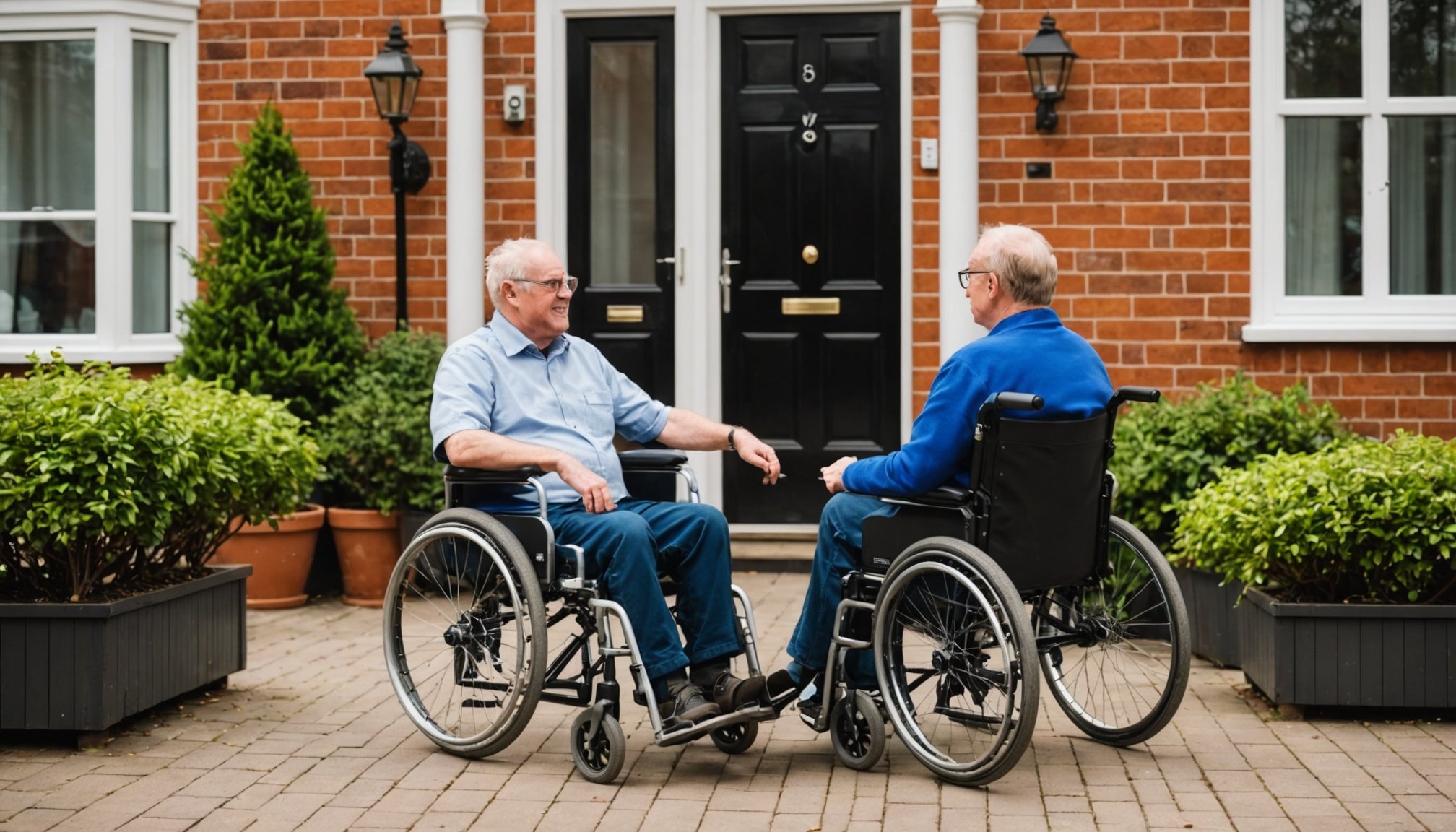Introduction to Disability-Friendly Living
Creating disability-friendly homes is essential for enhancing the everyday lives of individuals living with disabilities. An accessible living environment ensures safety, comfort, and independence, allowing individuals to engage fully in daily activities.
Designing a home with accessibility in mind involves an understanding of the unique needs and challenges faced by the disabled community. Common obstacles in these environments often include narrow doorways, inaccessible bathrooms, and difficult-to-use kitchen spaces. Addressing these issues through strategic home modifications is vital. For instance, widening doorways, installing ramps, and adding grab bars in bathrooms can greatly improve accessibility, reducing barriers faced by those with mobility impairments.
Cela peut vous intéresser : Unlocking Leicester”s Real Estate: The Impact of Local Economic Trends on Property Values
Moreover, accessible living is not only a matter of physical design. It’s about creating an inclusive environment where people with diverse abilities can thrive. Thoughtful home design acknowledges the varying capabilities of its residents and anticipates potential obstacles.
Manchester has shown a commendable commitment to accessibility, integrating inclusive principles into urban planning and housing projects. By prioritising disability-friendly homes, cities can foster environments that embrace inclusivity, supporting the autonomy and well-being of all residents. Recognising and implementing these critical home modifications is a step towards more inclusive communities.
Avez-vous vu cela : Essential Guide to Discovering Trustworthy Property Management Firms for International Landlords in the UK
Essential Features for Accessibility
Introducing accessible home features increases inclusivity and independence for all occupants. These modifications ensure everyone, including those with limited mobility, can move around their home with ease. An often-overlooked aspect is the importance of ramps and level access. These elements eradicate barriers posed by stairs, allowing seamless entry and exit for wheelchair users or those who find steps challenging.
Additionally, the necessity of wide doorways and open spaces cannot be overstated. Wide doorways facilitate smooth navigation with mobility aids and reduce the risk of accidents. They create open, uncluttered spaces that welcome movement, enhancing overall design modifications for accessibility.
Adapting bathrooms is also crucial for safety and usability. Essential accessibility elements such as grab bars, walk-in showers, and lowered countertops ensure these private spaces are secure and functional. Through thoughtful planning and design, bathrooms can become safe havens that support daily routines without compromising independence.
Each accessible home feature serves a purpose, either directly aiding movement or enhancing usability, demonstrating their importance in crafting spaces that truly serve every member of the household. By prioritising these elements, homes transform into environments that offer both comfort and accessibility, ultimately improving the quality of life.
Local Regulations and Standards
Understanding local regulations and standards is essential when undertaking renovations to ensure accessibility compliance. Legislation such as the Equality Act 2010 ensures that individuals with disabilities are not discriminated against, thereby necessitating adherence to specific building codes. Meanwhile, local building codes provide detailed requirements designed to make spaces accessible. For those planning renovations, obtaining the correct planning permissions is a critical initial step, particularly when major changes could impact accessibility.
Overview of Relevant Legislation
The Equality Act 2010 is a comprehensive law that promotes fair treatment and equality for those with disabilities. Relevant to this are local building codes, which outline the essential accessibility features required for public and private buildings. These codes ensure modifications support disability rights laws, providing equal access for everyone. Furthermore, planning permissions play a significant role, particularly in substantial renovations, as they require consideration of accessibility from the design phase.
Accessibility Standards to Consider
The British Standards for Accessible and Adaptable Homes offer a valuable resource for ensuring renovations are accommodating to all users. These standards provide guidelines for creating spaces that cater to varying disabilities, advocating for long-term compliance through adaptable design. Resources such as guidance documents and consulting services are available to help verify adherence, ensuring that renovations meet local building codes and accessibility regulations.
Resources for Modifications
Navigating the myriad of accessibility resources can be challenging, but in Manchester, there are several local organizations dedicated to assisting individuals in making necessary home modifications. These entities provide valuable support and guidance.
Local Charities and Organizations
Many charities in Manchester are committed to enhancing home accessibility. They offer assistance ranging from advice to hands-on help. Organizations such as Age UK and the Leonard Cheshire Disability are particularly noteworthy. They not only provide financial aid but also volunteer labour to modify homes for improved accessibility.
Government Grants and Funding
For those in need of financial assistance, the government offers several grants specifically aimed at funding accessibility modifications. The Disabled Facilities Grant is a key option, providing substantial funding to those eligible. It covers the cost of necessary changes like ramps, wider doors, and bathroom adaptations. To apply, contact your local council.
Professional Services
For a more tailored approach, consider hiring professional services specializing in accessibility assessments and renovations. These experts evaluate your home and propose modifications that cater precisely to your needs, ensuring both safety and independence. Local services in Manchester are well-equipped to provide comprehensive solutions, making the process smoother and more efficient.
Examples of Disability-Friendly Homes in Manchester
Designing accessible homes in Manchester involves various real estate adaptations tailored to meet diverse needs. Let’s explore some examples of these thoughtful modifications.
Case Study of a Renovated Home
A standout example of a successful disability-friendly renovation in Manchester is a Victorian terrace house transformed to boost accessibility. Key adaptations included installing ramps, widening doorways, and setting up non-slip flooring. The bathroom was fitted with grab bars and a walk-in shower, allowing ease of use for individuals with limited mobility. This renovation highlighted the importance of planning and the need for collaborative efforts between architects and homeowners, though challenges such as budget constraints and space limitations were a constant consideration.
Innovative Designs in New Builds
New housing projects in Manchester showcase innovative designs focused on accessibility from the outset. Examples include adjustable kitchen counters, open-plan layouts without barriers, and smart home technology that enables hands-free operation of various home systems. These designs not only assist wheelchair users, but also foster an inclusive environment for everyone. Communities have embraced these changes, enjoying improved access and heightened safety features. As these developments continue, they promise to shape neighborhoods into fully disability-friendly spaces.
Practical Tips for Making Homes Accessible
Creating an accessible home doesn’t have to be daunting. Begin with a step-by-step evaluation to identify accessibility needs. First, assess entryways for ease of access. Are there steps at the entrance that could be replaced with a ramp? Universal design principles suggest doorways should be at least 32 inches wide to accommodate wheelchairs.
Next, consider the layout of key rooms. In bathrooms, install grab bars near toilets and in showers. Kitchen counters may require height adjustments. For DIY enthusiasts, simple modifications can include installing lever-style door handles and pull-out shelves. Such changes are both affordable and effective ways to enhance accessibility.
Involving disabled individuals in the design process is crucial. They can provide insights into practical needs, ensuring solutions align with their daily routines. For instance, understanding specific challenges like reachability may guide where to place switches and outlets.
Cost-effective home improvement advice includes prioritizing projects. Start with essential areas like bathrooms and doorways, then expand to other parts of the home. Always keep universal design in mind—features beneficial for all users, creating a home both accessible and welcoming. Implementing these strategies ensures your living space meets diverse needs elegantly and efficiently.
Conclusion: The Future of Disability-Friendly Living in Manchester
The future of accessibility in Manchester holds promising developments aimed at facilitating inclusive living. These initiatives focus on removing barriers and enhancing the quality of life for people with disabilities.
In recent years, community efforts have grown significantly, demonstrating a robust commitment to bettering accessibility in public and private spaces. This progress stems from collaborative planning between local councils and community organizations, ensuring newly developed areas and renovations meet diverse needs.
Additionally, technology is playing a pivotal role. Smart home innovations and assistive devices are increasingly integrated into housing projects, making life easier and more comfortable for residents with disabilities. Not only do these advancements promote independence, but they also enhance safety and convenience in everyday living.
Educational programs and awareness campaigns are further fostering change by encouraging citizens to understand and participate in efforts toward inclusivity. These initiatives empower individuals to advocate for themselves and others, creating a supportive environment.
While Manchester has made significant strides, continual adaptation and community-driven projects will be essential to meet evolving needs. By prioritizing inclusive living, Manchester is on a path to becoming an exemplary model of accessibility, inspiring other cities to follow suit in creating a truly inclusive society for all residents.











